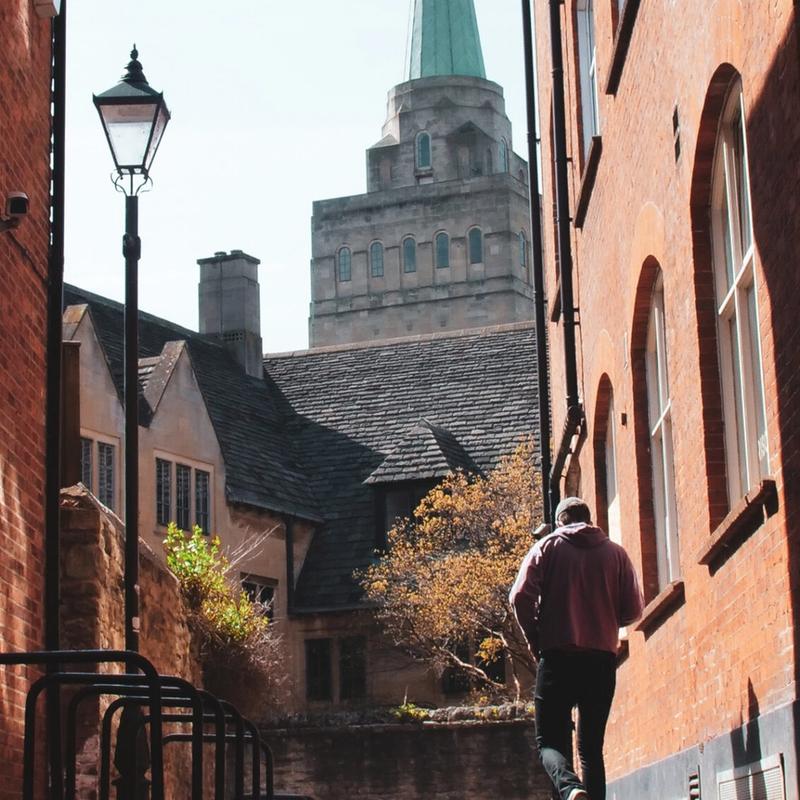This article is part of our series, “Cloud of Witnesses: Stories from the Church.” Read more from the series here.
“Do not go gentle into that good night.
Rage, rage against the dying of the light.”[1]
These lines conclude a poem Dylan Thomas wrote for his dying father. Though death is inevitable, Thomas argues in the poem, we should never accept it: “Old age should burn and rave at close of day.”[2] This attitude stands in stark contrast with the way believers should approach their death. The New Testament describes death as falling asleep. Death is not the end of existence; it’s the passage from this life to the next. Our frail and sinful bodies will fall asleep in death, only to awaken in the presence of God (1 Cor. 15:50–55). This truth ought to give peace and joy as death approaches.
However, that’s easier said than done. This offers one excellent reason to study men and women from church history—to learn how to die well. John Owen (1616–1683) provides an excellent example of how a follower of Christ ought to face death. Owen followed Christ and stayed true to his theological convictions all his life. Sometimes that meant that he had prestige and power. Other times it meant that he was oppressed and cast out of society. No matter how his circumstances changed, Owen looked to Christ and sought to serve him as honestly and faithfully as he could. As a result, Owen could approach his own death with hope and joy, not rage, regret, and despair. He gives us a powerful example of what it looks like for a Christian to die well.
Early Life & Education (1616–1641)
Born in Stadham, England, just 10 miles south of Oxford, John Owen was the second born son of a Puritan minister. The term “Puritan” is used by scholars in a variety of ways. It might refer to a Christian within the Church of England who wanted to reform a moderate amount of practices they thought were unbiblical. On the other hand, some labeled “Puritan” were more radical and, perhaps, heretical. John Owen’s father, Henry, was a moderate Puritan.[3] Owen was taught by his father until age 10. These early years of education would be formative for him as he would come to hold similar Puritanical theological convictions and hold fast to them all his life.
When he was 10 years old, Owen and his older brother attended a small school in Oxford, which would prepare them for Queen’s College in Oxford University, where Owen would graduate in 1632. He then went on to earn his Master of Arts degree in 1635. Owen was a good student, particularly excelling at Latin. Though he was academically inclined, Owen was not cooped up in a library all day and night. He was an athlete who ran and threw the javelin, as well as a musician (he played the flute). He approached all areas of his life with intensity, many nights only sleeping four hours. Later he would feel this had been a mistake as it was detrimental to his health.[4]
Owen’s time as an Oxford student came to an end sooner than he planned. He did not pursue a divinity degree because of the new university chancellor (i.e. president): William Laud. Laud was an advocate for a style of worship that a Puritan, like Owen, saw as a move back towards the Roman Catholic Church. Owen found that this was a difficult time to be a Puritan. The King, Charles I, banned debates over issues like predestination and election because they might spread a Puritan theology rooted in the teachings of the Protestant Reformer John Calvin. On the Oxford campus, the worship service at chapel was changed to be a “high liturgy,” which contained elements that Puritans saw as a rejection of the Reformation and a return to Roman Catholic practices and beliefs. As a result, Owen decided to leave Oxford to work as a chaplain and tutor for several employers until he moved to London in 1642.
The English Civil Wars (1642–1649)
The following years of Owen’s life are inextricably linked with the English Civil Wars, a conflict between the English Parliament, led by Oliver Cromwell, and King Charles I. During the years of the First Civil War (1642–1645), Owen to a large degree went on with his life. He wrote a theological work called A Display of Arminianism, became a pastor, and got married to Mary Rooke.[5] With the help of the Scots, Parliament won the First Civil War in 1645. Subsequently, Owen began to grow in notoriety. In April of 1646, he was invited to preach to Parliament, and in August, he was appointed pastor at a new, much larger church.
The Second Civil War (1648–1649) began after Charles I convinced the Scots to come over to his side. Owen supported Parliament and would become an important figure in their cause. Shortly after the Second Civil War began, Owen preached to Parliament’s New Model Army. That same day he befriended Cromwell’s son-in-law, Henry Ireton. This relationship would bring him into proximity with Cromwell himself. Once again, Parliament won the war. To solidify their victory—to the joy of some and astonishment of others—King Charles I was executed on January, 30, 1649. The very next day, Owen preached to Parliament.[6] He didn’t make any explicit reference to the decapitation of Charles, choosing not to comment on the previous day’s events. The choice to preach and not to mention the execution were (and are) controversial. In fact, the sermon was publicly burned shortly after Owen’s death.
Three months later, Owen preached before Parliament again, and this time Cromwell was in the audience. The next day, Owen met Cromwell, and Cromwell invited him to accompany him to Ireland as chaplain to Trinity College, Dublin. With the encouragement of his brother, Owen decided to take the job.[7] This meant that Owen was with the New Model Army as they lay siege to Drogheda, a Royalist city in Ireland that remained loyal to the monarchy. When Cromwell’s army took the city, they showed no quarter, and infamously, massacred many civilians. It doesn’t seem that Owen witnessed the carnage, though he was aware of exactly what atrocities happened. The next time he preached to Parliament, Owen was not silent about what Cromwell and his soldiers had done:
“How is it that Jesus Christ is in Ireland only as a lion staining all his garment with the blood of his enemies; and none to hold him out as a lamb sprinkled with his own blood to his friends?”[8]
In this instance Owen decided to directly address Cromwell and his army, calling them out for their barbarism which was without excuse. From this we can see that Owen was no mere “yes man” for the Parliamentarian cause. Through his life, he stuck to his convictions, whether they led to his rise in prominence or his fall from grace.
Owen’s Rise to Prominence (1649–1659)
Over the next few years, Owen was very successful. In 1649 he became official preacher at the palace of Whitehall, in 1650 he traveled with Cromwell to Scotland, in 1651 he was appointed dean of Christ Church college at Oxford University, and in 1652 Cromwell made Owen vice-chancellor of the university. A sermon series from these years would become one of Owen’s most famous books: On the Mortification of Sin.[9] Owen wrote several books during this time, though he felt like he could not write as he wanted to because of his heavy workload and his role as an advisor to Cromwell. He was busy, but things were going well. However, by 1657 political trouble was brewing. Some were proposing that Cromwell should become king. On March 31, 1657, he was actually offered the throne by some of his followers. Though it seems he was tempted to take the offer, Owen and others convinced Cromwell to refuse. This marked a cooling of the friendship between Cromwell and Owen.
The Restoration and the Great Ejection (1660–1672)
Once Charles I was executed, Parliament had established Cromwell as “Lord Protector” of the English Commonwealth. This government would only last until 1660, when Oliver Cromwell’s son Richard was unable to stop Parliament from reinstating the monarchy. Charles II was crowned on April 23, 1661 in what is known as “the Restoration.” This change meant that Owen, who had been on the side of Parliament, would face political challenges. He would be facing theological challenges as well, since his puritanical views on the worship and government of the Church of England meant that he was considered a “Nonconformist,” a label used for ministers who were opposed to various worship practices of the Church of England. These ministers were systematically targeted for years. The Corporation Act of 1661 said Nonconformists could not hold civic office, and the Act of Uniformity of 1662 said Nonconformists could not hold office in the church. As a result, around 2000 ministers—including Owen—were kicked out of the Church of England in what is called “the Great Ejection.”Then, in 1662, the Conventicle Act made Nonconformist meetings illegal. A few years later, the Five Mile Act of 1665 made it illegal for Nonconformist ministers to live within five miles of any place they had been a pastor.
As a Nonconformist, Owen also lost his job at Oxford. He moved to a small estate in Stadhampton where he defied the laws that prohibited him from ministering. If he had conformed, he likely could have been given a prestigious post at an important church in the Church of England. But Owen held true to his theological convictions, even when they were out of favor with the powers that be. Instead of a large, well-known church, he ministered to a small congregation several miles from Oxford. He was very loyal to his fellow Nonconformists and he turned down an invitation from the First Congregational Church of Boston to be their pastor.[10]
The Final Decade (1673–1683)
Though he was cast out from society, Owen’s last decade of life was still eminently productive. He primarily spent his time and energy writing, preaching, and counseling. This is all the more impressive when we consider the loss and suffering he endured over these years. In 1675, Owen’s wife, Mary, died. She had been with him for three decades, through the ups and downs of his public life, as well as the sorrows of their private lives. Of 11 children, only one survived to adulthood. Owen did not spend the final years of his life alone, however. A year and half after Mary died, he remarried a widow named Michel. During this time, Owen suffered from several severe health issues including asthma and gallstones. These illnesses often meant he was unable to preach, but Owen kept writing and publishing up until his death.
All said and done, scholars estimate Owen wrote and published 8 million words. Many of his books were on theological topics such as the doctrine of God, but he also wrote biblical commentaries, political and economic works, as well as a children’s book.[11] He truly was a prolific theologian and thinker. To the end, he stayed true to his convictions and clung to Christ as his only hope in life and death.
Only days before his death, Owen wrote these words in a letter to a friend,
I am going to Him whom my soul hath loved, or rather who hath loved me with an everlasting love; which is the whole ground of all my consolation. The passage is very irksome and wearysome through strong pains of various sorts which are all issued in an intermitting fever … Live and pray and hope and do not despair; the promise stands invincible that he will never leave thee nor forsake thee.[12]
When facing his impending death, Owen did not “rage against the dying of the light.” To be sure—he was honest about the difficulty and pain of death. He was suffering and he found the slow approach of death to be “irksome” and “wearysome.” Yet, he was not filled with rage, fear, sadness, or regret. Owen could die well because he knew that death was the path into the presence of his Savior. On the day of his death, Owen told his friend William Payne, “The long wished for day is come at last, in which I shall see that glory in another manner than I have ever done, or was capable of doing in this world.”[13] That evening, August 24, 1683, Owen, full of hope, passed from this world into the presence of his Savior. At last, his faith became sight.
[1] Dylan Thomas, Do Not Go Gentle Into that Good Night, https://poets.org/poem/do-not-go-gentle-good-night
[2] Ibid.
[3] Sinclair B. Ferguson, The Trinitarian Devotion of Joh Owen (Orlando: Reformation Trust, 2014), 3.
[4] Sinclair B. Ferguson, The Trinitarian Devotion of John Owen (Orlando: Reformation Trust, 2014), 5.
[5] Of their 11 children, only one survived to adulthood.
[6] You can read the sermon online at this following link (note that the preface erroneously dates the sermon to 1648 when it was delivered in 1649): https://ccel.org/ccel/owen/sermons/sermons.ii.iii.ii.html
[7] Sinclair B. Ferguson, The Trinitarian Devotion of John Owen (Orlando: Reformation Trust, 2014), 10.
[8] Qtd. in Sinclair B. Ferguson, The Trinitarian Devotion of John Owen (Orlando: Reformation Trust, 2014), 10. From The Works of John Owen, 8:235-36
[9] You can download the ebook for free: https://www.monergism.com/mortification-sin-believers-ebook-modernized
[10] Sinclair B. Ferguson, The Trinitarian Devotion of John Owen (Orlando: Reformation Trust, 2014), 20.
[11] Crawford Gribben, 10 Things You Should Know About John Owen, July 22, 2020. https://www.crossway.org/articles/10-things-you-should-know-about-john-owen/
[12] Qtd. in Sinclair B. Ferguson, The Trinitarian Devotion of John Owen (Orlando: Reformation Trust, 2014), 22-23.
[13] Qtd. in Sinclair B. Ferguson, The Trinitarian Devotion of John Owen (Orlando: Reformation Trust, 2014), 23.






